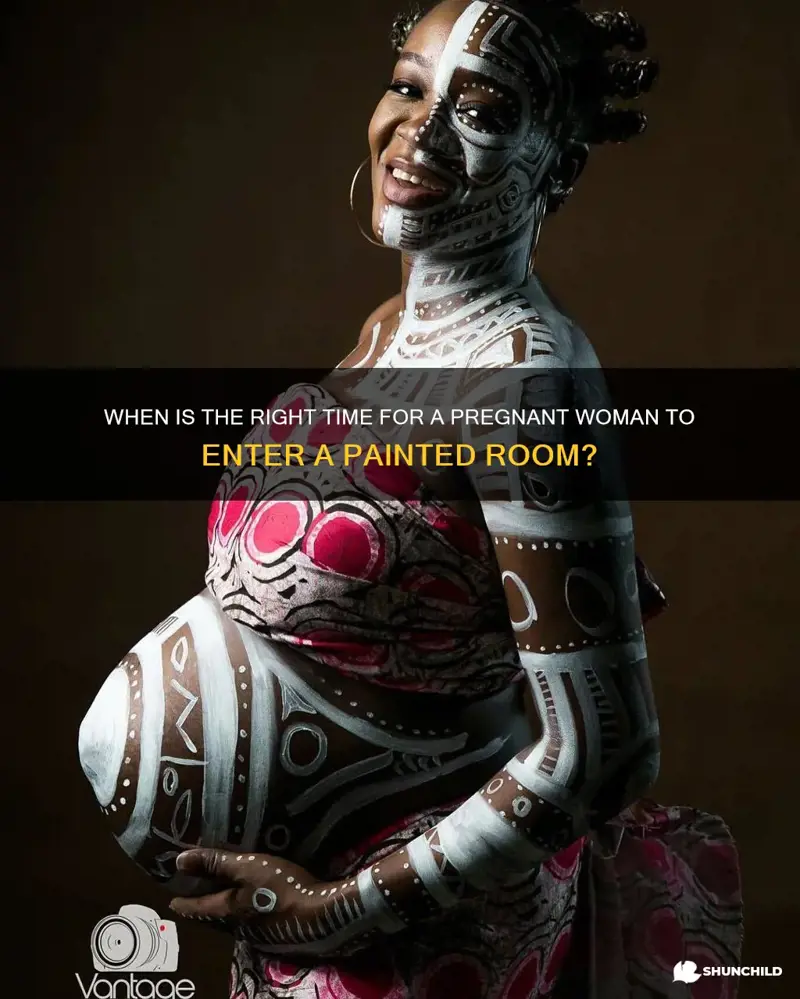
Did you know that the colors we surround ourselves with can have a significant impact on our mood and overall well-being? This is especially important for women who are trying to conceive. Creating a calm and soothing environment can help reduce stress and improve fertility. But how long before pregnancy should a woman enter a painted room? Let's dive into this fascinating topic and explore the optimal time for women to enter a freshly painted room when planning to conceive.
| Characteristics | Values |
|---|---|
| Duration of time before | |
| pregnancy woman should enter | |
| painted room |
What You'll Learn

Importance of waiting period after painting before getting pregnant
The arrival of a baby is an exciting and joyous time, and for many couples, preparing a nursery is an essential part of the process. From choosing the right colors to painting the walls, there's a lot to consider. However, before you start decorating your baby's room, it's important to be aware of the potential risks associated with painting and the importance of waiting for a period of time before getting pregnant.
Paints contain various chemicals, including Volatile Organic Compounds (VOCs) and other toxins, which can be harmful to both the pregnant woman and the developing fetus. These chemicals are released into the air as the paint dries, and exposure to them can have negative effects on the respiratory system, nervous system, and even the reproductive system.
When a woman is pregnant, her body undergoes numerous changes to support the growing fetus. These changes make her more susceptible to the harmful effects of VOCs, as her immune system and detoxification mechanisms may be compromised. In addition, the developing fetus is particularly vulnerable to these toxins, as their organs and systems are still developing.
To minimize the risks associated with painting and pregnancy, it is recommended to wait for a period of time before trying to conceive. This waiting period allows for the majority of the VOCs to evaporate, reducing the exposure to these harmful chemicals. While there is no specific guideline regarding the exact duration of the waiting period, experts suggest waiting for at least 2-3 months after painting the room before attempting to get pregnant.
In addition to waiting, it is essential to take certain precautions when painting or renovating a room while trying to conceive. Here are some key steps to follow:
- Choose Low VOC Paint: When selecting the paint for the nursery, opt for low VOC or zero VOC paints. These paints have lower levels of harmful chemicals and are less likely to emit toxic fumes.
- Ventilate the Room: Ensure proper ventilation by opening windows and using fans to improve air circulation during and after painting. This will help to reduce the concentration of VOCs in the room.
- Wear Protective Gear: When painting or working with any chemicals, always wear protective gear, including gloves, a mask, and goggles. This will minimize the direct exposure to harmful substances.
- Delegate the Task: If possible, delegate the painting task to someone else. This way, you can minimize the direct contact with paint and reduce the risk of inhalation of toxic fumes.
- Clean the Room Thoroughly: After painting, clean the room thoroughly to remove any residual dust or paint particles. Use a damp cloth or mop to minimize the spread of dust and ensure a clean and healthy environment.
By following these guidelines and waiting for an appropriate period of time after painting before getting pregnant, you can significantly reduce the potential risks to both you and your baby. Remember, the health and well-being of your baby should always be the top priority, and taking necessary precautions is crucial to ensure a safe and healthy start to parenthood.

Potential risks of inhaling paint fumes during pregnancy
Pregnancy is a beautiful and exciting time for a woman, as she eagerly anticipates the arrival of her little one. However, during this time, it is crucial for expectant mothers to prioritize their health and safety, as their choices can potentially impact the well-being of their unborn child. One potential risk that pregnant women should be aware of is the inhalation of paint fumes.
Paint fumes contain volatile organic compounds (VOCs), which are chemicals that can easily vaporize into the air at room temperature. These compounds can be present in both oil-based and water-based paints, as well as in the solvents used to clean brushes and other painting supplies. When these fumes are inhaled, they can enter the bloodstream and travel to the placenta, potentially affecting the development of the fetus.
Research on the exact effects of inhaling paint fumes during pregnancy is limited, but there is some evidence to suggest potential risks. Exposure to VOCs has been associated with an increased risk of respiratory problems, such as asthma, in children. Additionally, certain studies have linked prenatal exposure to paint fumes with a higher likelihood of the child developing attention deficit hyperactivity disorder (ADHD) or other behavioral issues.
With these potential risks in mind, it is important for pregnant women to take precautions when it comes to painting and being exposed to paint fumes. Here are some guidelines to follow:
- Limit exposure: If possible, avoid painting or being in a freshly painted room altogether during pregnancy. If you must be near a painted area, ensure that the room is well-ventilated. Open windows and use fans to circulate fresh air, helping to dissipate any lingering fumes.
- Choose safer alternatives: Opt for paint brands that are labeled as low-VOC or zero-VOC. These paints contain lower levels of harmful chemicals and are considered safer for indoor use. Additionally, try to use water-based paints whenever possible, as they tend to have fewer fumes compared to oil-based ones.
- Delegate tasks: If you have a painting project that needs to be done, consider asking your partner, a family member, or a professional to handle it. That way, you can avoid direct exposure to paint fumes altogether.
- Protective measures: In case you need to be near a freshly painted area, make sure to wear a mask that is specifically designed to filter out VOCs and other harmful particles. Additionally, wear protective gloves and clothing to minimize skin contact with potentially harmful substances.
- Timing is key: If you absolutely need to paint during pregnancy, try to do it well in advance. Aim to finish any painting projects at least a few months before your due date. This will give ample time for the room to air out and for any lingering fumes to dissipate, reducing the risk of exposure to both you and your baby.
In conclusion, it is best for pregnant women to avoid exposure to paint fumes whenever possible. By taking precautionary measures and following the guidelines mentioned above, you can help protect yourself and your unborn child from potential risks associated with inhaling paint fumes. Always consult with your healthcare provider if you have any concerns or questions about specific situations or projects.
Standing for Prolonged Periods During Pregnancy: Understanding the Impact on Back Pain
You may want to see also

Factors to consider when determining how long to wait after painting
When you’re pregnant and planning to paint a room in your home, one of the most important things to consider is how long you should wait before entering the newly painted space. It’s essential to ensure that the air quality is safe for you and your baby. While the smell of fresh paint may be pleasant, it can contain harmful chemicals that can be dangerous to a developing fetus.
Here are some factors to consider when determining how long to wait after painting before entering the room:
Choose low VOC (Volatile Organic Compounds) paint:
VOCs are chemicals found in many household products, including paint. They can negatively affect indoor air quality and can be harmful when inhaled, especially for pregnant women. Opt for low VOC or zero VOC paints, as they emit fewer harmful fumes, making it safer for you to enter the room sooner.
Ventilate the room properly:
Good ventilation is key to expelling the fumes and chemicals from the newly painted room. Open all windows and use fans to promote air circulation. Run fans for at least 48 hours to ensure proper ventilation before entering the room.
Allow the paint to dry completely:
Before entering the room, make sure the paint has dried completely. This process can take anywhere from a few hours to a few days, depending on the type of paint and the ambient temperature and humidity. Read the manufacturer's instructions for the specific drying time, and give it ample time to dry before entering the room.
Skip the re-entry if possible:
If you have the option to stay elsewhere temporarily during the painting process, it might be best to avoid entering the room until the paint has fully dried and the fumes have dissipated. Staying in a different area of your home or with a friend or family member can minimize your exposure to potentially harmful chemicals.
Consult your doctor:
Every pregnancy is unique, and it's important to consult your healthcare provider regarding any concerns or restrictions related to chemical exposure during pregnancy. Your doctor can provide personalized advice based on your specific situation and medical history.
In general, it's recommended to wait at least 2-3 days after painting before re-entering the room. This gives the paint ample time to dry and the fumes to dissipate. However, the duration may vary based on the factors mentioned above, such as the type of paint used and the ventilation in the room.
Taking these factors into consideration and following safety guidelines can help ensure a healthier environment for you and your baby. Remember, it's always better to err on the side of caution when it comes to protecting the well-being of your growing family.
Understanding the Signs and Symptoms of a Tubal Pregnancy
You may want to see also

Tips for preparing a safe and non-toxic environment for pregnancy
During pregnancy, creating a safe and non-toxic environment is crucial for the well-being of both the mother and the developing baby. One aspect of this is ensuring that any painted rooms in the house are free from harmful chemicals and odors. If you're thinking about repainting or embracing a freshly painted room, it's essential to consider how long you should wait before entering such spaces.
Paints, varnishes, and other lacquers often contain volatile organic compounds (VOCs) that can emit harmful gases into the air. These gases are known as off-gassing and can be harmful to a pregnant woman and the fetus. Therefore, it is essential to take certain precautions to minimize exposure to these chemicals.
The duration of time a pregnant woman should wait before entering a painted room depends on various factors. These factors include the type of paint used, the ventilation in the room, and the time that has passed since the painting was completed. Here are some general guidelines to follow to ensure a safe and non-toxic environment for pregnancy:
- Choose low or zero VOC paints: When selecting paints for your home, opt for low or zero VOC paints. These paints are specially formulated to have fewer harmful chemicals and odors, making them safer for both pregnant women and the environment.
- Proper ventilation: Before painting a room, ensure that the area is well-ventilated. Open all windows and doors to allow fresh air circulation. This will help to reduce the concentration of harmful gases and speed up the off-gassing process.
- Time since painting: The time you need to wait before entering a freshly painted room can vary. It is generally recommended to wait at least 24-48 hours after painting is completed before occupying the space. However, this duration can increase depending on factors such as the size of the room, the number of coats applied, and the type of paint used.
- Speed up the process: To expedite the off-gassing process, you can use fans or air purifiers with activated carbon filters. These devices help in removing airborne chemicals and reducing their concentration in the room.
- Reduce exposure: While waiting for the off-gassing process to complete, minimize your exposure to the painted room by staying in a different part of the house. Avoid sleeping or spending extended periods in close proximity to a freshly painted area.
- Take additional precautions: Consider wearing a respiratory mask and gloves when cleaning or moving items in a freshly painted room to further reduce exposure to harmful chemicals.
It's important to consult with your healthcare provider, especially if you have any specific concerns or health conditions. Some women may have sensitivities to certain chemicals or pre-existing respiratory conditions, which may require additional precautions or longer wait times before entering a freshly painted room.
Creating a safe and non-toxic environment during pregnancy is vital for the health and well-being of both the expectant mother and the baby. By following these tips and taking necessary precautions, you can minimize exposure to harmful chemicals and enjoy a safe and comfortable living space throughout your pregnancy.
Effective Ways to Prevent Pregnancy While Taking Lamictal
You may want to see also







